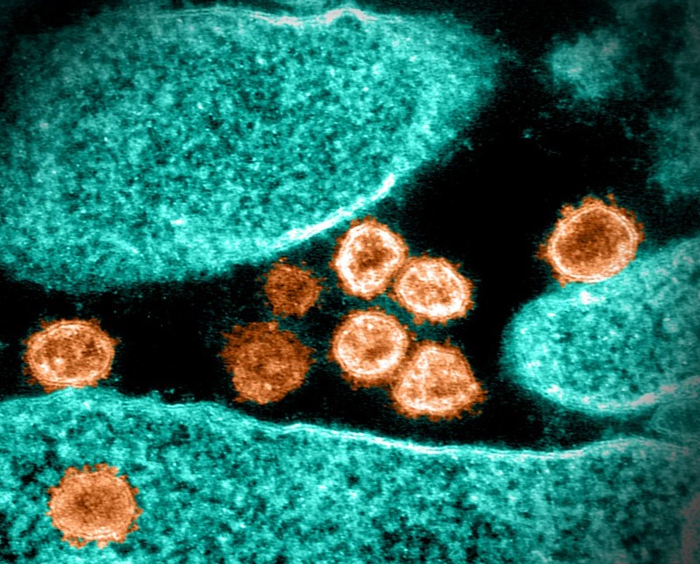A National Institutes of Health-funded study has found that people with food allergies are less likely to become infected with SARS-CoV-2, the virus that causes COVID-19, than people without them. In addition, while previous research identified obesity as a risk factor for severe COVID-19, the new study has identified obesity and high body mass index (BMI) as associated with increased risk for SARS-CoV-2 infection. In contrast, the study determined that asthma does not increase risk for SARS-CoV-2 infection.

Credit: NIAID
A National Institutes of Health-funded study has found that people with food allergies are less likely to become infected with SARS-CoV-2, the virus that causes COVID-19, than people without them. In addition, while previous research identified obesity as a risk factor for severe COVID-19, the new study has identified obesity and high body mass index (BMI) as associated with increased risk for SARS-CoV-2 infection. In contrast, the study determined that asthma does not increase risk for SARS-CoV-2 infection.
The Human Epidemiology and Response to SARS-CoV-2 (HEROS) study also found that children ages 12 years or younger are just as likely to become infected with the virus as teenagers and adults, but 75% of infections in children are asymptomatic. In addition, the study confirmed that SARS-CoV-2 transmission within households with children is high. These findings were published today in the Journal of Allergy and Clinical Immunology.
“The HEROS study findings underscore the importance of vaccinating children and implementing other public health measures to prevent them from becoming infected with SARS-CoV-2, thus protecting both children and vulnerable members of their household from the virus,” said Anthony S. Fauci, M.D., director of the National Institute of Allergy, and Infectious Diseases (NIAID), part of NIH. “Furthermore, the observed association between food allergy and the risk of infection with SARS-CoV-2, as well as between body-mass index and this risk, merit further investigation.” NIAID sponsored and funded the HEROS study.
Tina V. Hartert, M.D., M.P.H, co-led the research with Max A. Seibold, Ph.D. Dr. Hartert is director of the Center for Asthma and Environmental Sciences Research, vice president for translational science, the Lulu H. Owen Chair in Medicine, and a professor of medicine and pediatrics at the Vanderbilt University School of Medicine in Nashville. Dr. Seibold is director of computational biology, the Wohlberg and Lambert Endowed Chair of Pharmacogenomics, and a professor of pediatrics in the Center for Genes, Environment, and Health at National Jewish Health in Denver.
The HEROS study team monitored for SARS-CoV-2 infection in more than 4,000 people in nearly 1,400 households that included at least one person age 21 years or younger. This surveillance took place in 12 U.S. cities between May 2020 and February 2021, before the widespread rollout of COVID-19 vaccines among non-healthcare workers in the United States and before the widespread emergence of variants of concern. Participants were recruited from existing, NIH-funded studies focused on allergic diseases. Roughly half of the participating children, teenagers and adults had self-reported food allergy, asthma, eczema, or allergic rhinitis.
A caregiver in each household took nasal swabs of participants every two weeks to test for SARS-CoV-2 and filled out weekly surveys. If a member of the household developed symptoms consistent with COVID-19, additional nasal swabs were taken. Blood samples also were collected periodically and after a family’s first reported illness, if there was one.
When the HEROS study began, preliminary evidence from other research suggested that having an allergic disease might reduce a person’s susceptibility to SARS-CoV-2 infection. The HEROS investigators found that having self-reported, physician-diagnosed food allergy cut the risk of infection in half, but asthma and the other allergic conditions monitored—eczema and allergic rhinitis—were not associated with reduced infection risk. However, the participants who reported having food allergy were allergic to three times as many allergens as the participants who did not report having food allergy.
Since all these conditions were self-reported, the HEROS study team analyzed the levels of immunoglobulin E (IgE)-specific antibodies, which play a key role in allergic disease, in blood collected from a subset of participants. A correspondence between self-reported food allergy and food allergen-specific IgE measurements supports the accuracy of self-reported food allergy among HEROS participants, according to the investigators.
Dr. Hartert and colleagues speculate that type 2 inflammation, a characteristic of allergic conditions, may reduce levels of a protein called the ACE2 receptor on the surface of airway cells. SARS-CoV-2 uses this receptor to enter cells, so its scarcity could limit the virus’s ability to infect them. Differences in risk behaviors among people with food allergy, such as eating out at restaurants less often, also could explain the lower infection risk for this group. However, through biweekly assessments, the study team found that households with food-allergic participants had only slightly lower levels of community exposure than other households.
Previous studies have shown that obesity is a risk factor for severe COVID-19. In the HEROS study, investigators found a strong, linear relationship between BMI―a measure of body fat based on height and weight―and the risk of SARS-CoV-2 infection. Every 10-point increase in BMI percentile raised the risk of infection by 9%. Participants who were overweight or obese had a 41% greater risk of infection than those who were not. More research is needed to explain these findings. In this regard, planned analyses of gene expression in cells collected from nasal swabs of participants before and after SARS-CoV-2 infection may provide clues about the inflammatory environment associated with infection, which may change as BMI increases, according to the investigators.
The HEROS researchers found that children, teenagers and adults in the study all had around a 14% chance of SARS-CoV-2 infection during the six-month surveillance period. Infections were asymptomatic in 75% of children, 59% of teenagers and 38% of adults. In 58% of participating households where one person became infected, SARS-CoV-2 was transmitted to multiple household members.
The amount of SARS-CoV-2 found in nasal swabs, that is, the viral load, varied widely among study participants in all age groups. The viral load range among infected children was comparable to that of teenagers and adults. Given the rate of asymptomatic infection in children, a larger proportion of infected children with high viral loads may be asymptomatic compared to infected adults with high viral loads.
The HEROS investigators concluded that young children may be very efficient SARS-CoV-2 transmitters within the household due to their high rate of asymptomatic infection, their potentially high viral loads, and their close physical interactions with family members.
Further information about the HEROS study is available in this 2020 NIAID press release and at ClinicalTrials.gov under study identifier NCT04375761.
Reference: MA Seibold et al. Risk factors for SARS-CoV-2 infection and transmission in households with asthmatic and allergic children. A prospective surveillance study. Journal of Allergy and Clinical Immunology DOI: 10.1016/j.jaci.2022.05.014 (2022).
NIAID conducts and supports research—at NIH, throughout the United States, and worldwide—to study the causes of infectious and immune-mediated diseases, and to develop better means of preventing, diagnosing and treating these illnesses. News releases, fact sheets and other NIAID-related materials are available on the NIAID website.
About the National Institutes of Health (NIH): NIH, the nation’s medical research agency, includes 27 Institutes and Centers and is a component of the U.S. Department of Health and Human Services. NIH is the primary federal agency conducting and supporting basic, clinical, and translational medical research, and is investigating the causes, treatments, and cures for both common and rare diseases. For more information about NIH and its programs, visit https://www.nih.gov/.
NIH…Turning Discovery Into Health®
Journal
Journal of Allergy and Clinical Immunology
DOI
10.1016/j.jaci.2022.05.014




